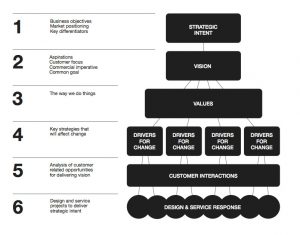
DBA Roundup
A roundup of industry expertise, exclusive resources, business support and tools for your design business.










History teaches us that strategy becomes more critical in the unforgiving times than good times. Experience demonstrates that design can make strategy not only visible but also tangible in many ways. And for busy people living and working in a world of ever more information and ever less time, the quickest and most effective means to manifest business strategy must be of particular interest.
As we confront harsh economic realities, making business strategy tangible is a compelling argument for design investment. And as organisations deal with increased competitiveness, reduced differentiation and increased costs, the role of design now and, more importantly, its potential to contribute to future development should come into sharper focus.
Design is much more than a nice-to-have in the good times. It is a valuable tool that lets a company communicate its strategy effectively by giving it the means to “live its business”. It makes it strategy visible and tangible in a relevant and powerful way at every organisational touchpoint. It is a process by which every aspect of an organisation including, but not just, its products and services, look, feel and become tangible through experience. Often design is narrowly defined as digital or graphic, corporate identity, signage and packaging design. In turn, the job of designers is even more narrowly defined as guardians and implementers of such identities, focusing on the detail of guidelines rather than the reality of the customer’s experience.
Design is much more a way of doing things rather than of just things.
Too rarely does design encompass every visible and experiential aspect of an organisation’s interaction with all its stakeholders. The exceptions to this sweeping generalisation are notable and are the much-cited proponents of ‘good’ design, including Lego, Apple, BT, Heathrow Terminal 5 and Philips. However, design is not just for the big boys. It is encouraging seeing small businesses such as Croots, a specialist leather goods maker, embrace design as a strategic tool and transform its business beyond all expectations. It won a DBA Design Effectiveness Award by presenting stunning results from its investment in design.
So, what is involved in delivering strategy and manifesting strategic intent? A key responsibility of business leaders is to understand what their future business could or should be like. Design leaders have an important role to play in this process: one of their core responsibilities is to work with the business to understand what its strategic options are and what these might look and feel like. Encapsulating a company’s vision is a fundamental role of design leadership. Envisioning enables everyone in the company, and all others with whom it deals, to relate to it. And a good way for design to become central to envisioning strategic intent and key to its day-to-day manifestation is to show the senior management team a road map for how it might contribute.
There isn’t one roadmap that fits all situations and businesses. Below is one I have found very effective as a starting point. Senior managers find it easy to understand and relate to. It can be understood whether you are looking at it from the boardroom or the factory floor through a series of clear connections between the two.
If you are looking at the diagram from the top down you can see how the strategic intent is going to be realised through the design projects the company invests in. If, on the other hand, you are involved in working on one of its design projects you can look up the diagram and see where it fits in to the wider picture and reassure yourself why this work is necessary.
If there are any business activities that do not fit into this diagram, the question must be asked: “Do they need them?”
 The roadmap has six key milestones
The roadmap has six key milestonesThese take many guises and I’ve heard them expressed in many ways. For instance, at one marketing conference I remember attending they tripped off a presenter’s tongue as soundbites: “A Coke within arm’s reach” or for the manufacturer of small Japanese engines: “Three in every garage”. These weren’t a comprehensive statement of corporate aims, but they make the point that such statements can direct much effort.
Strategic intent is not enough on its own; a vision is needed to capture the potential of that intent. A vision should describe the high ground implicit in the statement of strategic intent. It should also provide the platform for developing design and operational strategies to realise that intent. Eurotunnel’s vision was simple: a service where you could just turn up and go.
Previously booking was needed for a place on the ferry, which may not run anyway because of the vagaries of weather.
GloHealth, a new entrant into the private health insurance business based in Ireland, set its sights on “standing in our customers’ shoes” – something it believed no other health care insurer did well. The new high speed rail system planned for the next 25 years in Britain, HS2, has a far reaching design vision as a catalyst for growth across the country.
It sees the visionary challenge to “enhance the lives of future generations of people in Britain by designing a transformational rail system that is admired around the world”. These visions are ambitious and incredibly difficult to achieve. Nevertheless, without setting an audacious target how can you possibly hope to achieve the high ground that is appropriate to a company that wants to be an industry leader.
Before strategies can be developed, the corporate values that steer everything a company does need to be understood, as they condition the development of those strategies and everything that flows from them. These values should be specific to the business. There is nothing more useless than a set of values that are so generic they could be referring to any company – world class, efficient, user friendly and value for money all fit into this category. These fatuous words say nothing of any meaning about differentiation. Values should always be written in a way that shows why each is important. You should be able to complete the sentence ‘one of our values is … because it enables us to …’. Values should inform all aspects of a business – what you say, what you do, how you say it and what you believe.
It is only when these values are in place that a set of strategies can be developed that will be the key drivers for change. These strategies might be quite different in nature from each other, but all of them would be informed by the vision the business has created for itself. For example you may have a group of strategies that include radical product innovation; increased investment in R&D; a new recruitment programme to attract the latest bright minds; or a new way to raise market interest in the end product or service when it arrives.
A clear understanding of the potential for manifesting these strategies or drivers for change can be found through a detailed analysis of customer interactions with the business. This is where such tools as customer experience mapping and touch-point analysis can be of great help.
Every strategy will have a number of design responses to deliver it, and they all link back through the corporate values to the vision and strategic intent of the organisation. Without such alignment, shareholder value cannot be maximized from design investment, and no one can be sure that every design activity, and every pound spent on it, is contributing to the wider business ambitions.
Tim Selders of Park Advanced Design Management from the Netherlands notes that many leaders believe design is still seen as an operational benefit only and his research shows there is still much to be done before design is accepted as a core competency to help build business strategies. Those in the know – and those organisations that have already benefitted from a more sophisticated use of design – accept that design is a business tool that makes strategy visible.
So, what can we learn from this? Here are a few points:
The essence of an outstanding design solution and one that aligns perfectly with strategic ambitions, is an inspirational brief that clearly articulates business objectives. An inspirational brief reflects a deep understanding of the strategic context in which the business, product or service operates. Once a brief reflects the strategic intent of the business, clarifies a vision of the project at hand and reflects the values of the organisation commissioning it, an effective design response is likely.
Clarity and shared understanding at this stage are most likely to produce a response that is at minimum, acceptable and at best, exceptional in realising business need. So, design that makes strategy tangible and brings it to life is vastly more effective in both cost and communications terms than one that merely decorates a business card or the home page on the company’s website. Look at how Innocent has taken account of consumer concerns regarding traceability, ethics and sustainability, and have leveraged them to create very drinkable smoothies, a strong brand and exceptionally popular consumer promotions.
The idea that design can have a critical role in manifesting corporate strategy is one that is readily accepted by designers, although some still prefer the comfort zone of being involved in the designing of things rather than the directing of what should be designed and why. However, this link between business strategy and design is not yet readily accepted by many business leaders and it is the responsibility of design leaders to make the strategic importance of design clear.
Show how design can deliver corporate strategy, mission, vision or values and, in doing so, you provide a key link to design investment, briefing, development and implementation. A core responsibility of design leaders is to work with the business to understand what its strategic options are and what these might look and feel like.
Above all else, make it clear that design is a critical business tool that must be owned by the business – design is far too important just to leave to designers, as I hope this article has demonstrated.
Image credits: © Kelpfish | Dreamstime.com










The issue of elitism is never far away when considering the role of design in business. Elitism is generally used when describing attitudes and activities of a small select group of people. In this case the reverse is true. Far from being elitist, design should be inclusive by involving everyone in the company because it certainly will affect them; design is fundamental to creating and managing customer experience and many people in an organisation are in a position to make design-related decisions that influence this.
For example, designing a building in such a way that it is easy to keep clean is likely to mean that the janitorial staff will have as much effect on the quality of that experience, or the working conditions of staff, as designing for the chief executive’s long-term strategic intentions. Equally, understanding customer experience will enable businesses to exceed expectations and build loyalty.
When I was at BAA, for example, we undertook a comprehensive study of the experience passengers, staff, airlines and other business partners needed to have at every step of their journey to, through, and when using our airports. This then formed one of the cornerstones of the company’s ten-year design and development programme. It was key to ensuring the user was put at the centre of its design thinking and key to the programme’s success.
Equally, design is not an expensive new overhead but something that companies are already engaged in and could almost certainly do more cost effectively. Designing the right solution in the first place costs less than designing the wrong solution and then having to manage the fall out from that bad decision. There is well-documented evidence that design can save money, not only by making things easier and cheaper to produce, but also by having a positive effect on the cost of ownership.
Far from being irrelevant, design can be used to position a company in line with its strategic intent. It can influence how customers and staff experience the products and services of the company; it can make clear what the company stands for. It can overtly manifest its values through what it says about itself and how staff behave; it is key to defining, creating and maintaining differentiation. A great example of this approach is GloHealth. A new Irish based company in an already crowded marketplace, GloHealth wanted to be a business that provided the alternative way to private health insurance. The desire to differentiate itself from the rest of the industry had been fundamental to the creation of this business – how it looked, how it felt to work with, its product differentiation and the manner by which it did things. And it used strategic design thinking to do this. As GloHealth’s Chief Executive, Jim Dowdall puts it; “we know what makes us different and what this means to the products and services we offer. This difference is born out of a clear understanding of our strategic intent, vision, values, product design and quality of delivery. Collectively these summarise who we are and what we stand for.”
The arguments for design are comprehensive and profound. For example, the DBA’s Design Effectiveness Award competition has many examples of how design has had a transforming impact on business, government and society. Look for others within your own business. At BAA, I used the transformative nature of our Terminal 5 project to continually remind senior managers of the significance of design to our long-term strategic aims. There will almost certainly be many examples that resonate with most business situations and most industry sectors.
The truth is that design is not superficial; nor is it about finishing touches. It affects all parts of the business; it is key to making business strategy at least visible and potentially tangible in many other ways. Design is an essential ingredient that can breathe new life into old products and help create innovative new ones. It can be the basis of designing spaces from the inside out for user convenience, improved work dynamics and operational efficiency, rather than from the outside in for the aesthetic value of it. It can be the key to differentiation and growth in the marketplace.
And even when design is superficial, even when it is applied only at the very end of a project, it can still have huge impact. Whilst the dictionary definition of the word ‘superficial’ describes it as something to do with the surface of things, this does not always mean it is of no significance. Fashion is an area of design that has much to do with appearance, or things so called ‘superficial’, but it is a huge industry that employs millions of people and brings pleasure to many more. There is no better advocate for design than the converted sceptic. Once you have them fully on side, the next hurdles are much easier to clear.
This article is an extract from Crossing the Rubicon which featured in Design in Business.









